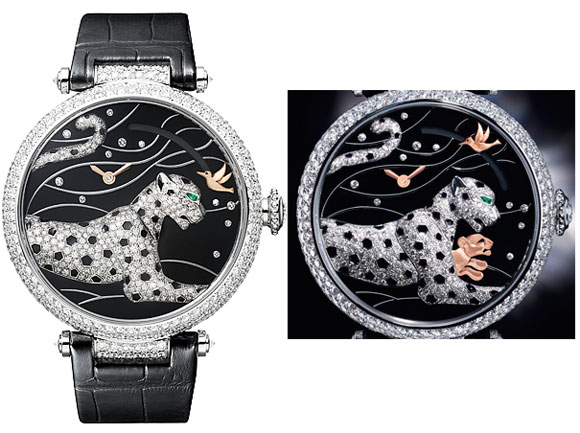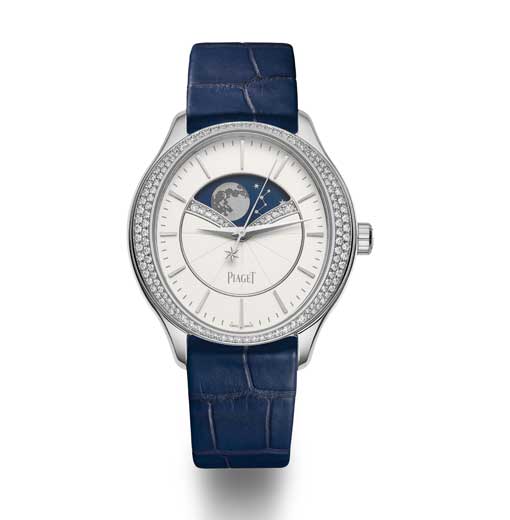This year’s SIHH did not disappoint when it comes to mechanical watches for women. We have a great line of them to show, so we will go in stages. Here we present three stunners — dazzling diamond-adorned beauties that house complicated movements.
Piaget, always a master at diamond work, unveils some stunning new Limelight watches this year, including the new Piaget Limelight Stella –a watch that deftly blends beauty and brains. The Limelight Stella is the brand’s first complication created especially for women. Designed and developed in house, the watch offers a stunning, diamond-adorned moon phase indication at 12:00. Since the dawn of time, we have had a love affair with the moon and the stars, and Piaget’s rendition of the moon reinforces that amore. The case of the watch is a stunner — with an oval / round look thanks to a double row of diamonds on the sides that taper to a single row at top and bottom. The look offers a play on shapes that is further enhanced by the moonphase.
What makes this moonphase indication so special are several factors. To begin with, the aperture alone is fan shaped – evoking a truly feminine appeal. The aperture base, like the base of a fan, is bedecked in diamonds. Also impressive is the astronomical moon depiction that reproduces the lunar cycle on the wrist with exceptionally precise beauty. Piaget accomplishes this by using a disk adorned with two moons and multiple stars – driven by a 135-tooth wheel that ensures the complication will need only a one-day correction after 122 years. The Caliber 584P powers the watch and, via a sapphire caseback, one can view the finely finished movement details. The watch is finished with a blue strap that emulates the blue of the moon.
Year after year, Cartier wows us with its superb panther motif and this year is no exception. Among other high-jeweled beauties, Cartier releases the Pantheres et Colibri, an unusual power-reserve indication watch with mother-and-baby panther, and an alluring Panthère Mystérieuse watch. The key features of the Cartier Panthères et Colibri with integrated complication are its on-demand mechanism that enables the gold baby panther hidden behind the diamond mother panther to peek out on demand. The creative display also features a hummingbird as the power reserve (3 day) indicator, and, in typical Cartier whimsical style, the baby panther’s paw reaches out to try to swat the hummingbird. All of this wonder takes place against a black diamond background with a filigree of vines. The Caliber 9915 MC powers the watch and its animated on-demand power reserve with manual winding. Created and built in house, the 367-part movement beats at 28,800 vibrations per hour. In total, the 18-karat white gold watch features more than 500 brilliant-cut diamonds.
At Roger Dubuis, this year has been dubbed the year of the Roger Dubuis Diva and to underscore the message, the brand unveils a host of artistic and technical creations developed solely for women. One such watch, the Velvet Secret Heart, is both a rhapsody in blue and in mystery. Created in white gold with a blue strap and blue dial – and surrounded in a double bezel of diamond brilliants – the Velvet Secret Heart has a special way of displaying time on the inner tonneau-shaped dial While the hours and minutes are displayed traditionally with hands, the date is displayed via two arc-shaped tracks on the outer edge of the dial thanks to a Bi-Retrograde jumping date. Essentially, the date starts at the left side of the dial, counting up from 1 to 15 with a tiny red hand and then disappearing at 6:00 (actually jumping back into position at 1 to begin its countdown again). The beat is then picked up on the right side of the dial where a second red date hand counts from 16 to 30. The tiny red date counter alternates from side to side of the dial for mesmerizing effect. The watch is powered by the 291-part bi-retrograde jumping date Caliber RD821B.
Suffice it to say that the “beat” started several years ago – to pay attention to women – has continued strongly without missing a tick. (This article by Roberta Naas first appeared on World Tempus.)








